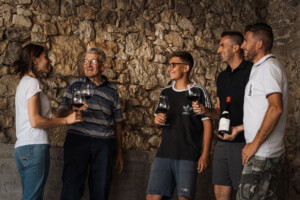Monte Castelon

The Tommasi family
About
Owners: Silvano, Maurizio, & Valentina Tommasi
Winemaker: Alessandro Castellani
Vineyards: 7ha, all estate-owned
Vineyard management: In conversion to certified organic farming
Soils: Calcareous clay
Grapes grown: Corvina, Corvinone, Rondinella, Molinara
Annual production: 13,000 bottles
Quick facts:
- Monte Castelon is a family project: Bruno Tommasi works alongside his children Silvano, Maurizio, and Valentina.
- The grapes for the Amarone are hand-selected and dried in wooden cases for over three months, developing aroma, color, and flavor.
- “The most important thing for us is family. We are not an industry, we are farmers and we are proud of it.” – The Tommasi family
The Tommasi family have been grape-growers for four generations, but they’ve only been winemakers for a handful of years. Bruno Tommasi always had the dream of making wine, and in 2015, the harvest was too good to resist–the family saved some grapes for themselves and made two barriques of Amarone. When the wine was ready, they fell in love with the results, and in 2018 Bruno established the Monte Castelon winery along with his children Silvano, Maurizio, and Valentina.
The family’s 7ha of vineyards are found at 400-530m above sea level on a south-facing slope, with rocky calcareous clay soils. Their high elevation gives them good wind circulation, ideal for organic farming, as well as slightly cooler temperatures, which are an advantage as the climate changes. They grow only indigenous grapes: mostly Corvina, with smaller plantings of Corvinone, Rondinella, and Molinara. As the family explains, “We love making wines here in Valpolicella because it’s our land. We were born here and we are lucky enough to have inherited these vineyards from previous generations.”
In an area with such well-known styles of wine, the Tommasi family aims to produce Valpolicella and Amarone wines that are typical for the region, while at the same time expressive of their own identity. The goal is to produce wines with freshness, even for styles incorporating dried grapes like Amarone and Ripasso. Most of the hard work is done in the vineyards, which are in conversion to certified organic farming. The vines are trained in the traditional Veronese pergola system and are harvested by hand. Wines are fermented exclusively with indigenous yeasts in stainless steel and aged in 2000L wooden vats or used barriques. The grapes for the Amarone are selected by hand from the best sites and dried slowly and naturally in wooden cases, from harvest in late September until the end of January.

